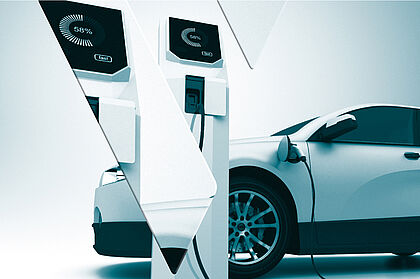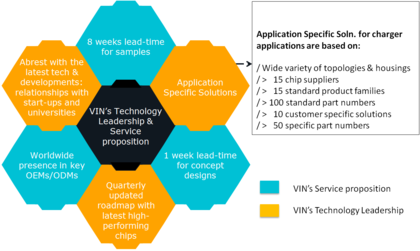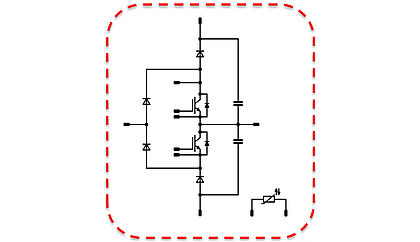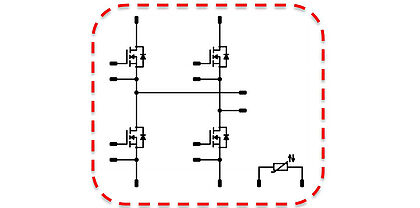Chargers for Electric Vehicles

The market for electric vehicles (EVs) has entered a phase of fast growth, boosted by a combination of vigorous support from governments and growing consumer appreciation for electric passenger vehicles. The latest forecasts suggest that EVs (that is, hybrid electric, plug-in hybrids and fully electric vehicles) will account for 30 % of new car sales by the year 2021.
A consequence of this growth in EV numbers on the road is that the number of public and private charging points will also grow fast. EV drivers will see a rapid build-out of charging infrastructure, including charging posts on-street and at workplaces and other public locations, low-power charging units at drivers’ homes, and very high-power fast-charge units at fuel filling stations. These static charging points to which a driver can connect their EV are also called off-board chargers, in contrast to the on-board chargers mounted inside a vehicle, which may be supplied with power by an ordinary 120 V/240 V wall socket or by a charging point.
The power delivery capability of charging points is commonly classed by reference to levels, with level 1 being the lowest-power charger, and level 3 the highest.
| Power Level Types | Charger Location | Typical Use | Power Level | Vehicle Technology |
|---|---|---|---|---|
Level 1 120 Vac (US) 230 Vac (EU) | On-board 1phase | Home/office | 1.4 kW 1.9 kW | PHEVs Evs |
Level 2 240 Vac (US) 400 Vac (EU) | On-board 1phase or 3phase | Private or public outlets | 4 kW 8 kW 19.2 kW | PHEVs EVs EVs |
Level 3 208-600 Vdc | Off-board 3phase | Commercial, same as a gas station | 50 kW 100 kW | EVs (20-50 kWh) |
The growth forecast (figure) has given rise to a huge, and global, opportunity for manufacturers of off-board EV chargers. Still in its infancy, this market is today highly fragmented, and supports a large number of manufacturers. Over time, consolidation is inevitable. So which factors will determine which companies are the winners and which the losers in the battle for market share?
At least in part, this will be a matter of which suppliers respond best and quickest to customers’ requirements. The customers for high-value off-board chargers are, for the most part, large organizations:
- Highway authorities or other governmental organizations responsible for sponsoring the build-out of EV infrastructure
- Vehicle service providers such as fuel (gas) station operators and highway (motorway) service station operators
- Electric utilities
These customers’ primary requirements are for:
- High power efficiency. By maximizing efficiency and minimizing conversion losses, customers can control their energy cost, which makes up a large proportion of their operating expenses, and minimize the CO2 emissions associated with generating the electricity they provide.
- The lowest possible purchase (capital) cost while maintaining a specified level of quality and reliability.
These requirements define the ground on which the battle between charger manufacturers will be fought. And this brings into the spotlight a strategic decision of crucial importance to the engineering teams designing the next generations of EV chargers. This decision is over the best way to implement the power circuit in each of the three power stages of an off-board EV charger: the input PFC (power factor correction) stage, the converter stage and the output rectifier stage.
Continual innovation in power semiconductors
If a priority for customers is high power efficiency, the principal driver of efficiency improvements in all types of power systems is semiconductor technology.
Advanced power semiconductor manufacturers such as Infineon, STMicroelectronics, Fairchild, ROHM Semiconductor and Wolfspeed are constantly innovating both in the fields of semiconductor materials and of circuit topologies, and continually introduce new products – such as IGBTs, MOSFETs and diodes – which offer incremental improvements in efficiency, as well as in other operating parameters.
Breakthroughs such as the commercialization of the high-performance silicon carbide (SiC) semiconductor material are bringing rapid improvement to the operation of MOSFETs and diodes. SiC is a near-ideal semiconductor material for the manufacturers of power ICs. Compared to silicon, it:
- Enables devices to switch faster, enabling the use of smaller, cheaper passive components
- Suffers from lower switching losses, resulting in more efficient power-conversion operation
- Withstands higher operating temperatures, which enables the user of smaller heat sinks, reducing the host system’s size and bill-of-materials cost
The semiconductor manufacturers' continual innovation in materials such as SiC, and their many new product introductions provide charger manufacturers with a means to meet customers’ demand for ever higher power efficiency. But the question for the manufacturers is, what is the best way to take advantage of the stream of new, improved power ICs that continually come on to the market, while maintaining tight cost control?
Rapid, low-cost implementation of new charger designs

This is a strategic question for charger OEMs: they will benefit from a long-term commitment to a specific plan for upgrading their products.
The problem for the charger OEM is that technology leadership in power ICs is not in the grip of a single supplier. At any given time, the most efficient power IC for any given application may be manufactured by STMicroelectronics, by Infineon, or by another semiconductor manufacturer.
In order to optimize the efficiency of their products, then, charger manufacturers need to continually modify and upgrade their designs to incorporate the latest new components. But the development and production costs associated with the introduction of brand-new product designs are very high. Normally, this limits the frequency with which OEMs can introduce new products to the market.
But what if new power ICs could be integrated into a charger’s design as often as every three months, at almost no development or production cost?
This is the promise of the Vincotech family of power modules, which includes products supporting various topologies used in each of the three power stages in a high-power off-board charger. The use of power modules is already common among charger OEMs. By implementing power circuits with modules, rather than ‘home-grown’ circuits developed by the OEM itself with discrete ICs and other components, OEMs gain several benefits:
Efficiency up and cost down in the PFC stage

The new symmetric three-phase PFC power module, flowSPFC 0, is designed to deliver extremely high efficiency of up to 99.2 %, and is marketed at a remarkably low price. This PFC module is the first building block in an EV charger application: optimal specifications at this stage can help the whole system design benefit from cost savings. It enables operation at fast switching frequencies of up to 75 kHz, and is based on ultra-fast and efficient IGBTs built with the latest bipolar transistor technology.
It comes in a compact, low-inductance flow 0 housing, and offers various maximum current ratings, making this one module suitable for many applications.
New H-bridge helps applications switch faster

The new fastPACK 0 SiC power module is the fastest representative of a new family of H-bridge products designed to be faster, cooler and more efficient. In this module, Vincotech has integrated a 900 V SiC MOSFET, which has better switching performance than 1200 V SiC MOSFETs and a higher safety margin than 650 V MOSFETs. This power module supports applications switching at up to 400 kHz. It also achieves much higher efficiency than comparable IGBT solutions, offering an 8 % increase in efficiency at light loads and a 3 % increase at full load.
It comes in a compact, low-inductance flow 0 housing with press-fit pins for high electrical performance, reduced EMI and easy assembly on the production line.
Alongside this flagship 900 V power module, Vincotech offers a complete portfolio of 650 V and 1200 V IGBT, silicon MOS and SiC MOS modules, to cover all operating conditions and designs.
- Modules allow OEMs to get to market faster, since they provide a complete, ready-made power circuit that can be dropped into a product design
- A module is supplied with full documentation, and is tested and verified, so it offers guaranteed performance in the application and eliminates development risk
- A module combines multiple power components in a single, thermally-efficient package. This makes tooling and production simpler and cheaper than a system populated with multiple discrete components. It also simplifies the manufacturer’s supply chain, dramatically reducing vendor and component count.
Charger OEMs derive all of these benefits when they use modules from Vincotech or from any other reputable module manufacturer. But Vincotech solves the crucial question for charger manufacturers: how to implement the latest, most efficient power semiconductors in charger designs rapidly, and at low cost?
There are two key elements to this proposition:
First, Vincotech is supplier-independent. Unlike module manufacturers such as STMicroelectronics, Fairchild and ROHM Semiconductor, it is not tied to the use of just the house brand of power ICs. Instead, it can use the best semiconductors available on the market, from any manufacturer.
Second, Vincotech maintains long-term, strategic product platforms. Within each platform, every module shares a common footprint and pin-out. This means that users of Vincotech modules can replace an older module with a new, upgraded module in an existing design with little or no requirement for a board re-spin or for new tooling or assembly modifications.
To enable rapid implementation of new semiconductor technology by charger manufacturers, Vincotech follows a quarterly product upgrade schedule, integrating new ICs into its module product families almost as soon as manufacturers release these ICs. As a dedicated power module manufacturer, Vincotech can bear the costs associated with this short product-development cycle, amortizing them over a broad customer base and high production volumes.
And as a specialist in the design and implementation of highly integrated power systems, Vincotech has the experience and expertise to optimize the performance of popular power topologies and to take advantage of new topologies developed by semiconductor manufacturers. The elements of its service and technology leadership are illustrated (figure).
This operating model enables Vincotech to offer the newest semiconductor technology in modules with market-leading efficiency. This is demonstrated by the specifications of the latest Vincotech modules aimed at off-board EV chargers, which are described below:
Conclusion
By basing new product designs on a strategic platform provided by Vincotech, charger OEMs can benefit from constantly upgraded products using the latest, most efficient semiconductor technology, without incurring the high development and production costs normally associated with a short product lifecycle. New Vincotech modules featuring the latest SiC and silicon semiconductor technology are described above.
The Vincotech platform gives the charger OEM an edge over slower-moving competitors who offer products based on older technology.
By standardizing on Vincotech modules, a charger OEM can maximize his design, production and supply-chain efficiency and expect to benefit from the wave of consolidation that the charger manufacturing market is set to experience in the coming years.

